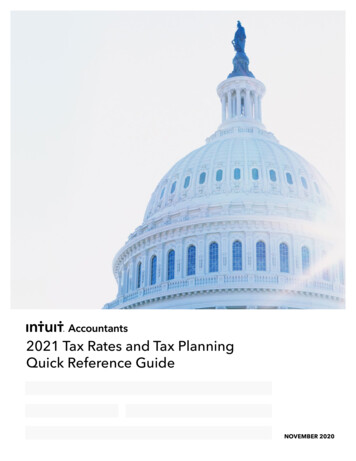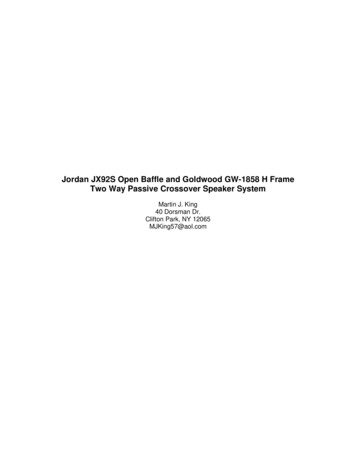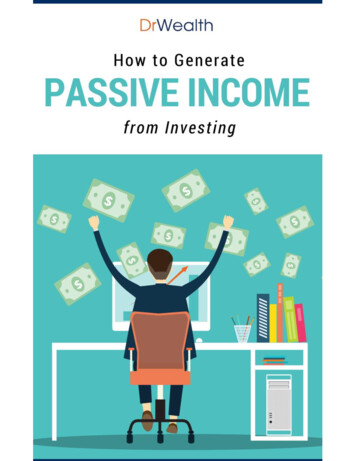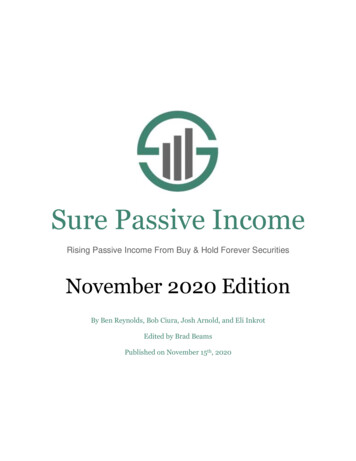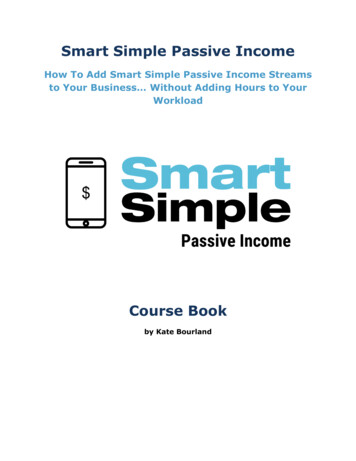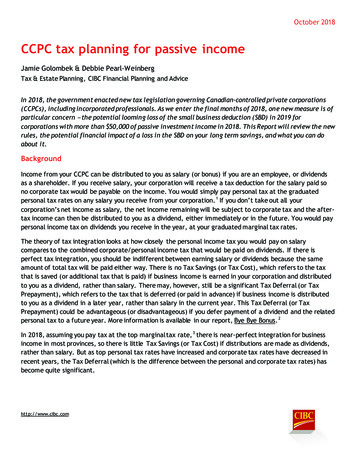
Transcription
October 2018CCPC tax planning for passive incomeJamie Golombek & Debbie Pearl-WeinbergTax & Estate Planning, CIBC Financial Planning and AdviceIn 2018, the government enacted new tax legislation governing Canadian-controlled private corporations(CCPCs), including incorporated professionals. As we enter the final months of 2018, one new measure is ofparticular concern ‒ the potential looming loss of the small business deduction (SBD) in 2019 forcorporations with more than 50,000 of passive investment income in 2018. This Report will review the newrules, the potential financial impact of a loss in the SBD on your long term savings, and what you can doabout it.BackgroundIncome from your CCPC can be distributed to you as salary (or bonus) if you are an employee, or dividendsas a shareholder. If you receive salary, your corporation will receive a tax deduction for the salary paid sono corporate tax would be payable on the income. You would simply pay personal tax at the graduatedpersonal tax rates on any salary you receive from your corporation. 1 If you don’t take out all yourcorporation’s net income as salary, the net income remaining will be subject to corporate tax and the aftertax income can then be distributed to you as a dividend, either immediately or in the future. You would paypersonal income tax on dividends you receive in the year, at your graduated marginal tax rates.The theory of tax integration looks at how closely the personal income tax you would pay on salarycompares to the combined corporate/personal income tax that would be paid on dividends. If there isperfect tax integration, you should be indifferent between earning salary or dividends because the sameamount of total tax will be paid either way. There is no Tax Savings (or Tax Cost), which refers to the taxthat is saved (or additional tax that is paid) if business income is earned in your corporation and distributedto you as a dividend, rather than salary. There may, however, still be a significant Tax Deferral (or TaxPrepayment), which refers to the tax that is deferred (or paid in advance) if business income is distributedto you as a dividend in a later year, rather than salary in the current year. This Tax Deferral (or TaxPrepayment) could be advantageous (or disadvantageous) if you defer payment of a dividend and the relatedpersonal tax to a future year. More information is available in our report, Bye Bye Bonus. 2In 2018, assuming you pay tax at the top marginal tax rate, 3 there is near-perfect integration for businessincome in most provinces, so there is little Tax Savings (or Tax Cost) if distributions are made as dividends,rather than salary. But as top personal tax rates have increased and corporate tax rates have decreased inrecent years, the Tax Deferral (which is the difference between the personal and corporate tax rates) hasbecome quite significant.http://www.cibc.com
CIBCCCPC tax planning for passive income — October 2018Tax DeferralThe new rules for passive incomeIn 2018, the top personal marginal tax rate thatyou would pay on ordinary income, including salaryor bonus, ranges from 47.5% in Saskatchewan to54% in Nova Scotia.When business income is distributed as salary (orwhen an unincorporated business owner earnsbusiness income personally), the business ownermust pay full personal tax in the year the income isearned. When business income is distributed asdividends, the corporate tax on the businessincome is lower than the personal tax rate onsalary, and personal tax on the dividend is onlypayable when the dividend is paid. If dividendpayments are deferred to a future year, additionalfunds are available to invest in the corporation inthe interim, which may yield more investmentincome over time compared to a business ownerwho invests after-tax salary personally.The SBD is available if your CCPC earns activebusiness income up to the annual small businesslimit (SBD Limit), which in 2018 is 500,000federally and in most provinces. 4 Income that iseligible for the small business deduction (SBDIncome) is taxed inside your corporation at alower, small business deduction tax rate (SBD Rate)that ranges from 10% in Manitoba to 17% in Quebecin 2018. Associated corporations must share theSBD.The government thought that this provided anunfair benefit for owners of CCPCs who chose todefer personal taxes by delaying the payment ofdividends and build up significant funds in theircorporations. With particularly low SBD Rates, thepotential benefit from the large Tax Deferral withSBD Income (Figure 1) was of most concern. Thenew tax rules will, therefore, limit the potentialfuture benefits from the Tax Deferral on SBDIncome by reducing the SBD Limit when acorporation has significant passive income in theprevious year.In 2018, if your corporation earns active businessincome (ABI) that is not eligible for the SBD, thereis a higher, general corporate tax rate that rangesfrom 26.5% in Ontario to 31% in Nova Scotia andPrince Edward Island.As a result, in 2018 there is significant TaxDeferral, ranging from 35.3% to 41% for SBD Incomeas shown in Figure 1 and ranging from 20.4% to 27%for ABI as shown in Figure 2.Figure 1: Tax Deferral on SBD Income left in thecorporation for all provinces in 2018ABBCMBNBNLNSONPEQCSKFigure 2: Tax Deferral on ABI left in thecorporation for all provinces in 40%
CIBCCCPC tax planning for passive income — October 2018Impact of losing the SBDBeginning in 2019, the federal 500,000 SBD Limitwill be reduced for CCPCs based on levels of“adjusted aggregate investment income” (AAII) inthe previous year. The SBD Limit will be reducedby 5 for each 1 of AAII that exceeds 50,000 andwill reach zero once 150,000 of AAII is earned in ayear. Additional information regarding AAII and thereduction to the SBD Limit is available in ourreport, The updated CCPC tax proposals. 5 Inpractical terms, this means that if your corporationhas at least 50,000 of AAII in 2018, then in 2019some (or all) of the income that would havequalified as SBD Income will be taxed as ABI.Is losing the SBD a big deal? The short answer is ‒ itdepends!If you are going to take the after-tax businessincome out of the company in the year it’s earned,then you’re not enjoying any Tax Deferral and theloss of the SBD is likely immaterial. Since there’snear-perfect integration for both SBD Income andABI, the total corporate and personal taxes will beabout the same with either dividends or salary.Figure 3 quantifies the after-tax amount that you’llreceive if 500,000 of business income is paid assalary (first column) or as dividends (columns 2and 3), using Ontario 2019 tax rates. If you earnedbusiness income personally, you would pay tax of53.53%. If the business income is earned in yourcorporation and distributed to you as a dividend,the combined corporate and personal taxes wouldbe only slightly higher and amount to 54.31% forSBD Income and 55.42% for ABI. As we can see fromthe bottom line in Figure 3, the difference in totaltax between SBD Income and ABI is about 1.11%.This means that if your corporation has more than 150,000 of AAII and completely loses the SBD in2019, it would only cost you 5,537( 500,000 x 1.11%).Just as associated corporations share the SBDLimit, AAII is combined for associated corporationsand the 50,000 threshold is shared between them.You may be surprised to find that anothercorporation with only a somewhat remoteconnection may be associated with yourcorporation. For instance, for the purpose of thenew rules you are deemed to personally own sharesheld by a trust in which you or your minor child is abeneficiary, so your corporation could beassociated with another corporation where theonly connection is shares held by a family trust. 6Figure 3: After-tax amount to business owner when 500,000 of active business income is distributed assalary or dividends in Ontario in 2019 7SalaryDividendsSBD ctive business incomeSalary expense500,000(500,000)Taxable income0500,000500,000Corporate tax0(62,500)(132,500)(70,000)0Amount available for dividends / 3.53%54.31%55.42%1.11%BUSINESS OWNER:Salary / dividendPersonal taxAfter-tax amount to business ownerTotal corporate/personal tax amountTotal effective tax rate3
CIBCCCPC tax planning for passive income — October 2018earned 500,000 of business income in 2019 thatwas distributed to you as dividends. It is assumedthat business income would be taxed in 2019 ateither the SBD or ABI rate, that the after-taxbusiness income would be invested in yourcorporation and, at the end of the period, allafter-tax corporate income would be distributed asa dividend that was taxed in your hands at the topmarginal rate. After 40 years, you would have 847,100 if your corporation invested after-tax SBDIncome or 742,600 if your corporation investedafter-tax ABI.The real concern with losing the SBD, so that some(or all) of the income that would have qualified asSBD Income is taxed as ABI, is the lower TaxDeferral (as shown in Figure 2).The line that is labelled “Amount available forinvestment / dividends” in Figure 3 shows theamount that can be paid as dividends. If dividendsare paid in a future year, this amount can beretained in the corporation and invested for yearsto come, until dividends are paid. With ABI (whenthe SBD is not available), there is 70,000 less toinvest than with SBD Income, which can make a bigdifference with years of investing.Comparing the ABI and SBD Income lines in Figure 4illustrates the impact of earning at least 150,000of AAII in 2018, so that the SBD Limit would bereduced to zero in 2019 (and all income that wouldhave qualified as SBD Income would be taxed asABI). With ABI, we saw in Figure 3 that the lowerTax Deferral would leave 70,000 less to invest in2019 than with SBD Income, which would translateto 104,500 ( 847,100 - 742,600) less cash to youover a 40-year period.Figure 4 shows the after-tax amount that would beavailable to you over 40 years, assuming 2019Ontario tax rates, if 500,000 of business income isearned and after-tax income is invested to earn 5%of ordinary investment income.Figure 4: After-tax amount to shareholder over40 years with 500,000 of business income and5% interest earned on investments, with 2019Ontario tax rates 1,000,000While this example shows ordinary investmentincome, taxed annually inside the corporation, thedecrease in wealth from losing the SBD is evengreater if other types of income such as capitalgains or Canadian dividends are earned inside thecorporation. And if the SBD is lost in multipleyears, the loss in wealth would be multiplied foreach of those years.SBD Income 847,100 800,000ABI 742,600 600,000Salary 582,300 400,000Some business owners are not affectedby new passive income rules 200,000 00102030The good news is that if you have a CCPC that doesnot earn any business income that could be taxedat the SBD Rate, the new tax rules for passiveincome will not affect you at all. For example, ifyou have a holding company (or other CCPC) thatearns only passive investment income, you cannotlose access to the SBD because you have no activebusiness income. Also, incorporated professionalsin large professional service firms (such as lawyersor accountants) may already have very limited (or40The “Salary” line in Figure 4 shows what wouldhappen if your corporation distributed 500,000 ofbusiness income to you as salary/bonus in 2019 andyou invested your after-tax salary in a nonregistered account. In 40 years you would have 582,300 after-tax.The two lines for SBD Income and ABI in Figure 4show what would happen if your corporation4
CIBCCCPC tax planning for passive income — October 2018no) access to the SBD if there is a group ofassociated corporations that must share the SBD.Removing funds that would otherwise be investedwithin the corporation could reduce future AAII.This is another reason to consider withdrawingsufficient salary or dividends from a privatecorporation to maximize contributions to RRSPsand TFSAs. Receiving salary of at least 147,222 byDecember 31, 2018 will allow the maximum RRSPcontribution of 26,500 in 2019. (TFSA contributionroom is not dependent on income level.)Reasonable salaries may also be paid to familymembers who work in the business to allow themto make contributions to RRSPs and TFSAs.As well, as was shown in the section titled “Impactof losing the SBD,” if you are distributing allbusiness income as dividends in the current year,you won’t be affected as there is no Tax Deferralto lose. Similarly, if there is only a short timehorizon until dividends will be paid, the impact ofthe new rule may be minimal.Finally, if your corporation, along with associatedcorporations, does not currently earn more than 50,000 of AAII in a year, the new passive incomerules do not affect you.It should be noted, however, that where salary ispaid there may also be various associated payrolltaxes, such as Canada or Quebec Pension Planpremiums, Employment Insurance premiums andprovincial health taxes to consider.Planning ideas to preserve the SBDin 2019Assuming that a corporation is nearing orexceeding the 50,000 threshold for AAII, here aresome strategies to consider to reduce the impactto the SBD Limit.Tax-free withdrawalsConsider whether any amounts can be withdrawnfrom the corporation on a tax-free basis that wouldotherwise be invested in the corporation. Forinstance, if a shareholder previously made a loanto the corporation, and those funds are no longerrequired by the corporation, consider if theshareholder loan can be repaid.Withdrawals to permit RRSP/TFSAcontributionsGiven current tax rates, where you are a businessowner who wants to get the most from yourinvestments over the long run and your portfolioearns a combination of interest, eligible dividendsand capital gains, consider withdrawing sufficientcorporate funds to maximize your RRSP and TFSAcontributions, rather than leaving the funds insidethe corporation for investment. Given sufficienttime, RRSP and TFSA investing would outperformcorporate investing when earnings come frominterest, eligible dividends, annual capital gains, ora balanced portfolio. Only corporate investmentsexclusively earning deferred capital gains wouldgenerally outperform RRSPs and TFSAs; however,few investors would be likely to defer 100% ofcapital gains over a long period of time. Theseresults are further outlined in our reports RRSPs: ASmart Choice for Business Owners 8 and TFSAs forBusiness Owners A Smart Choice. 9Capital dividends can be paid without beingincluded in the shareholder’s income. A capitaldividend may be paid at any point in time whenthere is a positive balance in the Capital DividendAccount (CDA) of a corporation. Certaintransactions, such as the realization of capitalgains and the tax-free death benefit from acorporately-owned life insurance policy, result inadditions to the CDA, while other transactions,such as capital losses, cause a reduction to theCDA.Investment strategiesAny reduction to the SBD Limit is based on AAII inthe previous year. Depending on the level of AAIIotherwise earned in a particular year, you maywish to consider investments that lean towards5
CIBCCCPC tax planning for passive income — October 2018An IPP is a defined benefit pension plan, meaningthat the pension paid on retirement is set out by aformula so the amount of the pension benefits ispredictable. Since the corporation contributes tothe IPP and the income earned in the IPP does notbelong to the corporation, that income is not AAII.growth rather than annual interest or dividendincome, as you may better be able to time therecognition of a capital gain. In addition, sincecapital gains are only 50% taxable, it would take 100,000 of realized capital gains to generate 50,000 of passive income that is counted towardsthe AAII test.Another advantage of an IPP is that the corporationmay be able to make higher contributions to theIPP than you could have made into an RRSP. This,in turn, may lead to higher tax-deferredaccumulation inside the IPP than you could havebuilt up inside an RRSP.Consider a “buy and hold” strategy to defer capitalgains if a corporation is approaching the 50,000AAII threshold in 2018. By deferring some capitalgains, the SBD Limit may be maintained in 2019. Itmay also be possible to stagger dispositions ofinvestments between calendar years. For example,if there will already be more than 150,000 of AAIIin one year, consider triggering additional capitalgains in that year, rather than the next, if thatmight reduce AAII below the threshold in the nextyear. Conversely, you may wish to trigger capitalgains or losses in a specific year because capitallosses cannot be carried forward to a future yearfor purposes of reducing AAII. As a result, you maywish to realize capital losses and gains in the sametaxation year.An IPP also allows you to split any pensionpayments with your spouse or common-law partnerany time after age 55, 10 rather than having to waituntil age 65 as would be the case for RRIF income.The tax benefits of an IPP need to be offset againstthe administrative costs, including actuarial costs,to set up and maintain the plan.Life insuranceYou may choose to invest after-tax income of thecorporation into a corporately-owned life insurancepolicy that insures the life of the business owner,or some other individual. There are numerousreasons to hold life insurance in a corporation,including certain tax benefits. For instance, thereis generally a lower after-tax cost of the insurancepremiums, which can be paid with funds that aretaxed at a lower tax rate inside the corporationthan funds that are earned personally. Dependingon how long the life insurance is held, the deathbenefit may flow out to the corporate shareholderson an entirely tax-free, or partially tax-free, basisvia the CDA. 11Some investments, such as certain notes, T-classunits of mutual funds and REITs, pay a mixture ofincome and a return of capital. A return of capitalis not included in income in the year received;rather, it reduces the adjusted cost base of theinvestment and increases the capital gain (ordecreases the capital loss) on the futuredisposition of the investment.When considering these investment strategies, youshould take into account your overall investmentplan, as well as AAII expectations for future years.Individual Pension PlansNow that AAII could impact the SBD Limit, lifeinsurance may offer an additional advantage. Aslong as the income from the investmentsunderlying the life insurance policy is not includedin the corporation’s income on an annual basis, itshouldn’t be included in AAII. This will be the casefor permanent life insurance policies qualifying asAn Individual Pension Plan (IPP) is a pension plancreated for one person, rather than a large groupof employees. An IPP could be a strategy toconsider once AAII nears or exceeds the 50,000threshold.6
CIBCCCPC tax planning for passive income — October 2018Conclusion“exempt policies.” 12 That means, permanent,exempt life insurance may be an alternativeinvestment solution for business owners to considerwhere there is a life insurance need as well as aconcern that the corporation’s AAII could limitaccess to the SBD.Although the new passive investment rules forprivate corporations do not come into effect until2019, as an incorporated business owner it is bestthat you start thinking about these now. Since 2018investment income in your private corporation mayreduce the SBD Limit in 2019, you may wish to takesteps in 2018 to potentially minimize the reductionof the 2019 SBD Limit. This decision should takeinto account whether a reduction in the SBD Limitwill result in a decline in any Tax Deferral, with aresultant reduction of future after-tax funds towithdraw from your corporation.DonationsIf you are considering making a charitabledonation, consider whether that donation can bemade from your private corporation, rather thanby you personally. Not only will your corporationreceive a deduction for the amount of thedonation, making a donation will reduce the fundsthat may be invested in your corporation toproduce AAII.As with all tax planning, be sure to discuss theabove strategies with your tax advisor to make surethey are appropriate for you.There could be additional tax benefits if yourcorporation makes an in-kind donation of publiclylisted securities or mutual funds with unrealizedcapital gains. First, no tax will apply to the capitalgains on the donated securities. Second, the entirecapital gain is added to the CDA and capitaldividends can be paid to the extent that there is apositive balance in the account, as discussed in thesection called “Tax-free withdrawals.” You canthen receive capital dividends, which are generallytax-free, instead of taxable dividends. Third,capital gains on donated securities are excludedfrom AAII, so they will not impact the SBD Limit inthe following year.Jamie.Golombek@cibc.comJamie Golombek, CPA, CA, CFP, CLU, TEP is theManaging Director, Tax & Estate Planning withCIBC Financial Planning and Advice in Toronto.Debbie.Pearl-Weinberg@cibc.comDebbie Pearl-Weinberg, LLB is Executive Director,Tax & Estate Planning with CIBC Financial Planningand Advice in Toronto.7
CIBC1234CCPC tax planning for passive income — October 2018Payroll taxes, such as premiums for the Canada/Quebec Pension Plan, Employment Insurance or provincial health taxes, that may be payablewhen income is distributed as salaries have not been considered.The report Bye Bye Bonus is available online at https://www.cibc.com/content/dam/personal banking/advice hout this report, it is assumed that you are the shareholder of a CCPC (your corporation) and you pay tax at the highest marginal tax rateon income distributed from your corporation.For large CCPCs, the federal and provincial SBD Limit is reduced on a straight-line basis for CCPCs that, in the prior tax year, had taxable capitalbetween 10 million and 15 million. In Saskatchewan, the SBD Limit is 600,000. In Manitoba, the SBD Limit is 450,000 in 2018 but will rise to 500,000 in 2019.5The report The updated CCPC tax proposals is available online athttps://www.cibc.com/content/dam/small business/day to day banking/advice centre/pdfs/business reports/private-corporation-taxchanges-en.pdf.6For further information see "The Passive Investment Rules and Their Associates", Michael Goldberg, Tax Topics (Wolters Kluwer), No. 2426,September 6, 2018.7Results will vary for other provinces/territories.The report “RRSPs: A Smart Choice for Business Owners” is available online athttps://www.cibc.com/content/dam/small business/advice en.pdf.89The report “TFSAs for Business Owners A Smart Choice” is available online athttps://www.cibc.com/content/dam/small business/day to day banking/advice centre/pdfs/personal finances/tfsas-for-business-ownersen.pdf.10Age 65 for province of Quebec.The amount of the death benefit, less the adjusted cost base of the insurance policy, is added to the corporation’s CDA account. As discussedabove, a positive balance in the CDA account may be paid out as a tax-free capital dividend. The adjusted cost base of the insurance policy willdecrease over time until it eventually reaches zero.If a life insurance policy does not qualify as an exempt policy, then the amount included in the corporation’s income annually in respect of thepolicy will be included in AAII.1112Disclaimer:As with all planning strategies, you should seek the advice of a qualified tax advisor.This report is published by CIBC with information that is believed to be accurate at the time of publishing. CIBC and its subsidiaries and affiliates arenot liable for any errors or omissions. This report is intended to provide general information and should not be construed as specific legal, lending, ortax advice. Individual circumstances and current events are critical to sound planning; anyone wishing to act on the information in this report shouldconsult with his or her financial advisor and tax specialist.CIBC Cube Design is a trademark of CIBC.8
CCPC tax planning for passive income — October 2018 . 4. The real concern with losing the SBD, so that some (or all) of the income that would have qualified as SBD Income is taxed as ABI, is the lower Tax Deferral (as shown in . Figure 2). The line that is labelled “Amount avail
